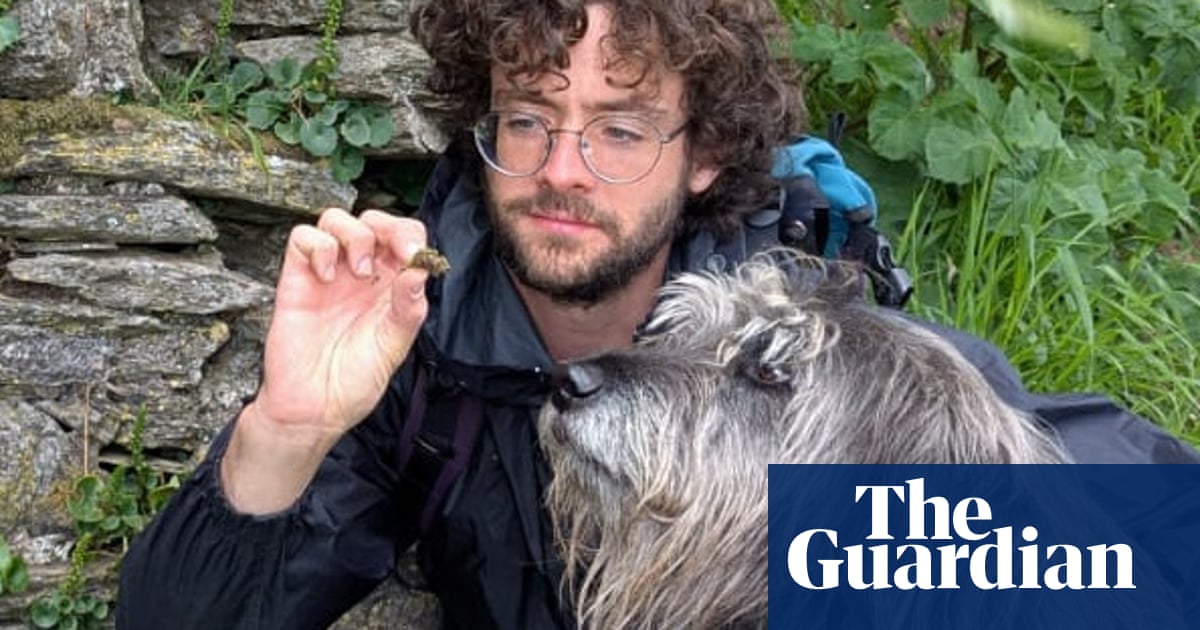Less than a millimetre in length, the squishy, transparent animal was completely unaware of my presence, my entire existence, while I watched it in awe. On my computer screen, where I gazed at the image generated by a cheap USB microscope, the water bear stumbled over grains of eroded rock and plant matter, an assemblage of soil, and I felt amused by its bumbling nature. Like someone trying to move through a field of beach balls, I thought.
I had found thiswater bear, or tardigrade, in a clump of moss I collected during a wet and windy walk with our dog, Bernie, in late 2021. After changing into dry clothes, I rinsed the moss with water and removed the excess using coffee filter paper. Transferring the residue soil and stray moss leaves – known as phyllids – to a small glass bowl, I found the water bear within minutes, but I don’t know how long I then spent watching the little animal manoeuvre through its microscopic kingdom. Time seemed to stand still, my eyes glued to the screen.
I had been feeling overwhelmed about the state of the world: the climate crisis, ecological devastation, Russia’s invasion of Ukraine and growing political toxicity. But my microscope was a portal into a life indifferent to humanity, oblivious to our often reckless actions.
Water bears have existed in a similar form since the Cambrian period, a time when evolution came up with some of its most zany creations, such as the aptly namedHallucigeniathat had 10 tube-shaped legs and 14 punk rock-like spines along its back. Surviving through five mass extinctions, tardigrades are a small but charismatic reminder of life’s resilience through the ages.
The day before I found my first tardigrade, I had met with a researcher at the University of Plymouth who studied them for his PhD. Seeing his laboratory-reared animals inspired me to seek out my own. Finding one in the wild made me think of the early microscopists of the 17th century who first saw these animals – or “animalcules” as they called them – in the dirt collected from their gutters.
Not only are tardigrades adorable, like sentient gummy bears with a pig-like snout for a mouth, they can withstand the most brutal conditions without harm. Blasted with radiation that would kill a human in seconds, heated to 130C or frozen to near-absolute zero (the temperature at which all motion, at the atomic level, ceases) – they endure. Their recent rise in popularity, especially in YouTube videos, has certainly come from their paradoxical mix of squishy cuteness and extreme indifference to stress.
I also found comfort in this animal for a slightly different reason. Yes, being able to survive in space or being frozen solid is incredible. But these little animals are also unperturbed by the future planet we are creating. One studyfound they were unfazedby simulations of even the worst-case scenarios of climate change, a warming of 5C by 2100, which had “no detectable effect on the tardigrade community”.
Seeing this creature for myself, knowing that it lived in my neighbourhood, felt like a balm against the age of extinction in which we are living.But I also felt a more personal kinship within this moment of observation: it was a reminder not just of the water bear’s ability to endure hardships, but of my own.
As a boy growing up in a village in North Yorkshire, unable to understand my mum’s depression and her struggles with alcohol, I turned to nature as an escape from a confusing and often lonely home life. Shy and introverted, I found solace in scrapbooks, filling their pages with detailed descriptions of animals from distant lands, reminders of a living world far beyond the hills and valleys I roamed.
My dad, who had worked in construction his whole life and stopped any scientific education before his O-levels, helped nurture my interests as best he could. Together, we built a pond from plywood and a plastic tarp, a portal into one of the most incredible metamorphoses in nature: a tadpole transforming into a frog. As I revised for my biology and chemistry exams, he would ask me questions from my notes and celebrate my answers, as if he was learning along with me, which he undoubtedly was.
I was given an enormous amount of freedom to explore, to follow a path of my choosing. My mum, on her good days, always instilled a sense of “do what you enjoy”. My obsession with nature became a refuge, somewhere that was as much a part of myself as it was a tangible place I could run to.
Since that first tardigrade, I have seen many others in the moss growing around my home. There are ones like the Michelin man, all segmented and chubby, and there are others with scutes of armour that remind me of a microscopic mashup of an armadillo and a woodlouse. All have the same chubby eight legs adorned with bear-like claws.
Knowing that these tiny animals are all around has brought a dramatic shift in perspective; a walk into the garden feels like a reminder of life’s resilience, a journey from the alien world of the Cambrian to the future climate we are creating. A cushion of moss, just like the first one I collected, is the continued expression of a living planet.
Super Natural: How Life Thrives in Impossible Places by Alex Riley is published by Atlantic Books on 5 June (£22). To support the Guardian buy a copy atguardianbookshop.com. Delivery charges may apply.
